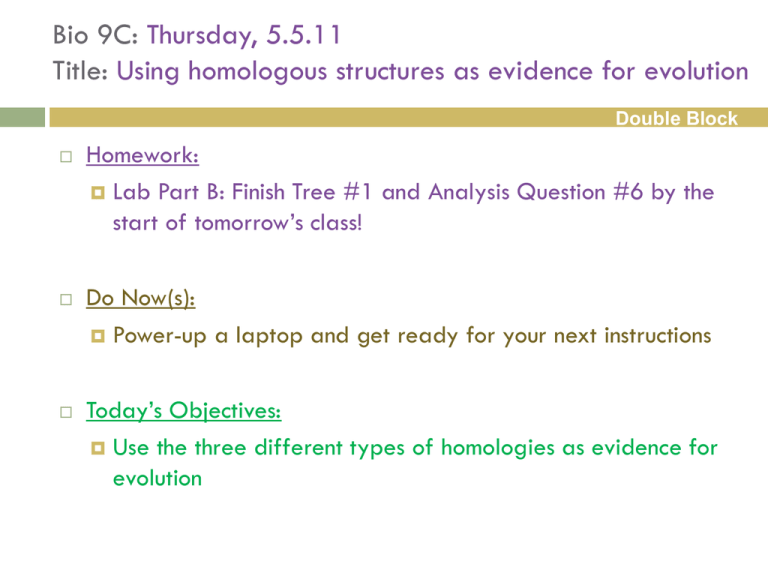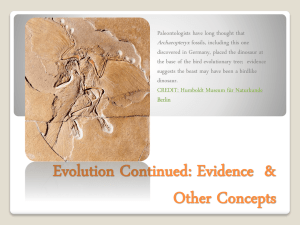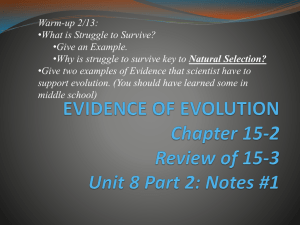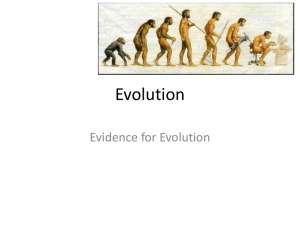evidence for evolution
advertisement

Bio 9C: Thursday, 5.5.11 Title: Using homologous structures as evidence for evolution Double Block Homework: Lab Part B: Finish Tree #1 and Analysis Question #6 by the start of tomorrow’s class! Do Now(s): Power-up a laptop and get ready for your next instructions Today’s Objectives: Use the three different types of homologies as evidence for evolution EVIDENCE FOR EVOLUTION PHA Biology 9 Moretti/ Dickson Evolution 3-Part Investigation Dry Lab Key Questions: 1. What is the evidence that one species can branch into two? 2. What is the evidence that multiple species are evolutionarily related? Objectives for Class: • Use the three different types of homologies as evidence for evolutionary relationships Evidence for Evolution Dry Lab: Part A Evolution Dry Lab Part A Part A Computer Lab All in the Family: Which Animals are the Closest Relatives? Link: http://www.pbs.org/wgbh/evolution/change/family/index.html The purpose of this series of lab activities is for you to… Examine and understand the evidence for evolution Use that evidence to infer evolutionary relationships and build phylogenetic trees Part A focuses on using the three different types of homologies as evidence for evolutionary relationships Objectives for Class: • Use the three different types of homologies as evidence for evolutionary relationships EVIDENCE FOR EVOLUTION What is the evidence that all species on earth are related to each other and share common ancestors? 3 Major Types of Evidence: 1. Homologous Structures a) Anatomical homologies and vestigial structures b) Embryological/ Developmental c) Molecular/Genetic 2. Fossils 3. Geographic Distribution of Species Objectives for Class: • Compare and contrast anatomical, genetic, and developmental homologies as evidence for evolution Evidence: HOMOLOGOUS STRUCTURES HOMOLOGOUS STRUCTURES Similar structures due to sharing a common ancestor that had those structures Three Types of Homologies: 1. Anatomical (including vestigial traits) 2. Embryological/ Developmental 3. Molecular/ Genetic Objectives for Class: • Describe the three different types of homologies and give examples of each Evidence for Evolution Begin notes for type of Evidence for Evolution Anatomical Homology Similar body parts or bone structures They don’t necessarily have the same function now, but did in the common ancestor Ex: human arm, cat leg, whale flipper, bat wing all have same bones Objectives for Class: • Compare and contrast anatomical, genetic, and developmental homologies as evidence for evolution Don’t confuse Homologous Structures with Analogous Structures Analogous Structures structures that have the same function but NOT the same skeletal structure This suggests these organisms did NOT descend from a common ancestor with that trait Ex: insect wing and bird wing Bird wing Insect wing bio.miami.edu Objectives for Class: • Compare and contrast anatomical, genetic, and developmental homologies as evidence for evolution Anatomical Homology: Vestigial Traits Vestigial Traits Don’t have a function now, but suggest that they descended from an ancestor that did use them. Examples: www.toptenz.net human tailbone, human goose bumps, ostrich wings Ex: human tail bone, human goose Objectives for Class: • Compare and contrast anatomical, genetic, and developmental homologies as evidence for evolution animal.nationalgeographic.com Embryological/Developmental Homology Similar characteristics appearing during specific embryonic/ developmental stages of development Examples: fish, reptile, bird, and human embryos all have gill slits and a tail (but some lose these features before birth) Objectives for Class: • Describe the three different types of homologies and give examples of each Molecular/Genetic Homology Comparing the similarities and differences of DNA or amino acid sequences for different organisms Closer the similarities = Closer relationships Objectives for Class: • Compare and contrast anatomical, genetic, and developmental homologies as evidence for evolution Phylogenetic Tree for All Living Things Time -------------------------------------------------------------------->present Nodes indicate most recent common ancestor of two branches Evidence for Evolution Dry Lab: Part B – Day 1 Evolution Dry Lab PART B – Day 1 Part B: Comparing Anatomical and Genetic Evidence The purpose of this series of lab activities is for you to… Examine and understand the evidence for evolution Use that evidence to infer evolutionary relationships and build phylogenetic trees Part B focuses on comparing and contrasting anatomical and genetic homologies as evidence for evolution Complete through Tree # 1 using the evidence for Tree 1 Objectives for Class: • Compare and contrast anatomical, genetic, and developmental homologies as evidence for evolution Bio 9C: Friday, 5.6.11 Title: Using homologous structures as evidence for evolution Homework: No Homework (unless you need to catch-up) Do Now(s): Label the front right-hand corner of your Evolution Lab B: CU = Finished Tree #1 and totally understand how the info in the table makes the tree CD = Finished Tree #1, but don’t understand how the info in the table makes the tree DC = Did not complete the table or the tree Today’s Objectives: Compare and contrast anatomical and genetic homologies as evidence for evolution Describe how fossils are used as evidence for evolution and give one example that illustrates this Do Now – Part 2 Which organisms branched off before evolving a complete digestive tube? Which three organisms have a brain? Evolution Dry Lab PART B – Day 2 Part B: Comparing Anatomical and Genetic Evidence The purpose of this series of lab activities is for you to… Examine and understand the evidence for evolution Use that evidence to infer evolutionary relationships and build phylogenetic trees Part B focuses on comparing and contrasting anatomical and genetic homologies as evidence for evolution Complete Tree #2 and ALL analysis questions Objectives for Class: • Compare and contrast anatomical and genetic homologies as evidence for evolution EVIDENCE FOR EVOLUTION 1. Homologous Structures a) Anatomical homologies and vestigial structures b) Embryos c) Molecular/Genetic 2. Fossils 3. Geographic Distribution of Species Bio 9C: Monday, 5.9.11 Title: Using fossils as evidence for evolution Homework: Reading Guide to movie Do Now: What are the differences between Analogous and Homologous structures Today’s Objectives: Describe how fossils are used as evidence for evolution and give one example that illustrates this. Describe how genetic evidence is used as evidence for evolution. Recap: Analogy vs. Homology Analogous Structures – similar structures due to natural selection in similar environments common ancestor did not have it, but descendents evolve it independently Homologous Structures – similar structures due to shared ancestry common ancestor had this feature, so all descendents have it Results from divergent (branching) evolution DIVERGENT (branching) EVOLUTION Evidence: FOSSILS Fossils show species that are now extinct show transitions to new body forms Example: Tiktaalik (lived 375 million years ago) fish with legs and (maybe) primitive lungs… earliest amphibian? Fossil Artist Rendering Objectives for Class: • Describe how fossils are used as evidence for evolution and give one example that illustrates this. Evidence: FOSSILS cont. Example: Archaeopteryx (lived 150 million years ago) earliest bird… but has many dinosaur features www.ansp.org Objectives for Class: • Describe how fossils are used as evidence for evolution and give one example that illustrates this. Evidence: FOSSILS cont. Interpreting Fossil Evidence Fossils form in layers of rock (older = lower layer) Fossils in the same layer lived at the same time Radiometric dating: determine the age of a fossil based on how much radioactive carbon it contains Objectives for Class: • Describe how fossils are used as evidence for evolution and give one example that illustrates this. What lived at the same time as the fossil fish? Objectives for Class: • Describe how fossils are used as evidence for evolution and give one example that illustrates this. What Darwin Never Knew http://video.pbs.org/video/1372073556 Chapters: 9 - Gene Switches 10 – A Transitional Form 11 – Fins to Limbs 12 (start at 1:26) Evidence: GEOGRAPHIC DISTRIBUTION Species that live on the same continents are often closely related to each other Based on genetic (DNA) and embryonic evidence This is true, even though they look more similar to species elsewhere. Example: North vs. South American rodents Objectives for Class: • Describe how fossils are used as evidence for evolution and give one example that illustrates this. Evidence: GEOGRAPHIC DISTRIBUTION Example: Placental Mammals vs. Australian Marsupial Mammals Australia has been separated from other continents for a long time, so its marsupials evolved independently Marsupial traits are analogous, NOT homologous, to placental mammals Bio 9C: Tuesday, 5.10.11 Title: Using fossils as evidence for evolution Homework: Completed lab is due Thursday at the start of class. Do Now: How are fossils used as evidence Today’s Objectives: Describe how fossils are used as evidence for evolution and give one example that illustrates this. Describe how genetic evidence is used as evidence for evolution. Evidence for Evolution: Part C How did whales evolve? 9C: Room 107 Crystal Jamesly Front of Room Amando Carla Asarel Julian Amanjot Obayanna Anthony Lilliana Jason Rockens Meryem Brunyr Marie Joe Sophie Jhon Karen Kendra Marcus Garlyn Christine Jonathan Evolution Dry Lab PART C – Day1 Part C: How Did Whales Evolve? The purpose of this series of lab activities is for you to… Examine and understand the evidence for evolution Use that evidence to infer evolutionary relationships and build phylogenetic trees Part C focuses on using fossil evidence and anatomical homologies to determine evolutionary relatedness Complete Tasks 1-4 before watching the video You may also have the reading to go along with this video: http://www.pbs.org/wgbh/evolution/library/03/4/l_034_05.html Objectives for Class: • Describe how fossils and anatomical homologies are used as evidence for evolution Ambulocetus natans in action A reconstruction of an early close cousin of whales Shown here with the kind permission of artist Carl Buell. http://www.indiana.edu/~ensiweb/lessons/whale.ev.html Bio 9C: Wednesday, 5.11.11 Title: Using fossils as evidence for evolution Homework: Complete analysis question for Part C by tomorrow. Do Now: Take Today’s Objectives: Describe how fossils are used as evidence for evolution and give one example that illustrates this. Describe how genetic evidence is used as evidence for evolution. Check the Answers… Check the Answers… Evolution Dry Lab PART C – Day2 Part C: How Did Whales Evolve? The purpose of this series of lab activities is for you to… Examine and understand the evidence for evolution Use that evidence to infer evolutionary relationships and build phylogenetic trees Part C focuses on using fossil evidence and anatomical homologies to determine evolutionary relatedness Complete Task 5 after watching the video You may also have the reading to go along with this video: http://www.pbs.org/wgbh/evolution/library/03/4/l_034_05.html Objectives for Class: • Describe how fossils and anatomical homologies are used as evidence for evolution Modern Whales… Where Did Whales Evolve From? Zooming in on Whale Evolution Bio 9C: Thursday, 5.12.11 Title: Evolution Review Homework: Study for Tomorrow’s Test Pass Part C to the left Do Now: Today’s Objectives: Describe how fossils are used as evidence for evolution and give one example that illustrates this. Describe how genetic evidence is used as evidence for evolution. EVOLUTION SUMMARY Populations of living things change over time. Due to change over time, a species can evolve into one or more new species. This results in the branching view of the tree of life. All living things are related because we all evolved from a common ancestor. Phylogenetic Tree for All Living Things Time -------------------------------------------------------------------->present “There is grandeur in this view of life…” – Charles Darwin Evolution Review In your own words, describe the four key steps/ideas of natural selection and explain how they relate to each other. (you may want to think of this in terms of an example). Write a paragraph describing an example of how the steps of natural selection (above) work in a population (examples could include hummingbird beaks, finch beaks, antibiotic resistance in bacteria, sickle cell anemia and malaria, or another example of your choice). Define what a species is. In your own words, explain the 2 main steps of speciation (one species dividing into two species). Describe at least four types of evidence used to determine evolutionary relationships between species. Give an example of each! Interpret or draw phylogenetic trees. Block 2 Dinosaurs: Return to Life Complete the “guided viewing” packet while watching the video. Write additional questions on the back of the sheet while viewing We will follow-up with a short discussion after the movie. Bio 9C: Friday, 5.13.11 Title: Evolution Test Homework: Now Homework Do Now: Put all of your stuff in your bag and zip them up! Today’s Objectives: Assess your understanding of the major concepts from the Evolution Unit









